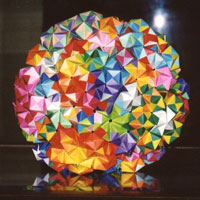The great rhombicosidodecahedron is the 62-faced Archimedean solid with faces . It is also known as the rhombitruncated
icosidodecahedron, and is sometimes improperly called the truncated icosidodecahedron
(Ball and Coxeter 1987, p. 143; Maeder 1997; Conway et al. 1999), a name
which is inappropriate since truncation would yield
rectangular instead of square.
It is illustrated above together with a wireframe version and a net
that can be used for its construction.
It is also the uniform polyhedron with Maeder index 28 (Maeder 1997), Wenninger index 16 (Wenninger 1989), Coxeter index 31 (Coxeter
et al. 1954), and Har'El index 33 (Har'El 1993). It has Schläfli
symbol t and Wythoff symbol
.
Some symmetric projections of the great rhombicosidodecahedron are illustrated above.
The great rhombicosidodecahedron is an equilateral zonohedron and is the Minkowski sum of five cubes. It has Dehn invariant 0 (Conway et al. 1999) but is not space-filling.
Its skeleton is the great rhombicosidodecahedral graph, illustrated above.
The inradius of the dual, midradius of the solid and dual, and circumradius of the solid
for
are
|
(1)
| |||
|
(2)
| |||
|
(3)
|
The great rhombicosidodecahedron has surface area
|
(4)
|
and volume
|
(5)
|

The great rhombicosidodecahedron constructed by E. K. Herrstrom in origami is illustrated above (Kasahara and Takahama 1987, pp. 46-49). This construction uses 900 sonobè units, each made from a single sheet of origami paper.
The dual polyhedron of the great rhombicosidodecahedron is the disdyakis triacontahedron, both of which are illustrated above together with their common midsphere.
